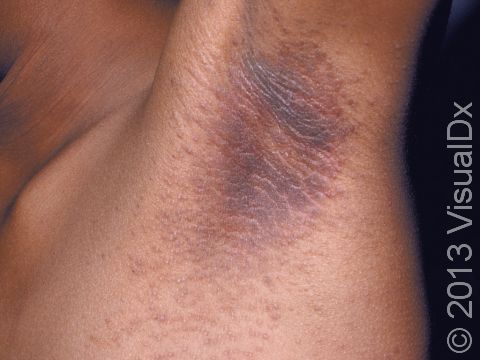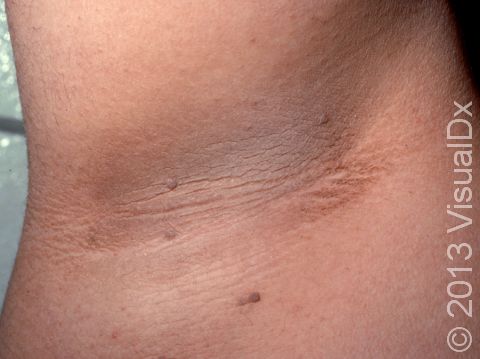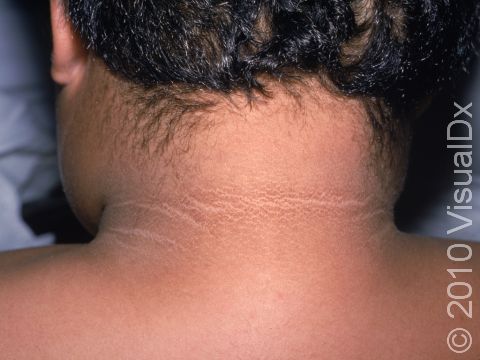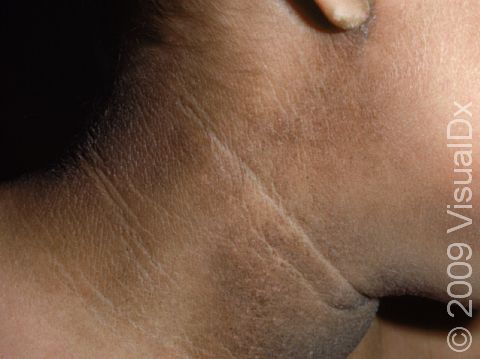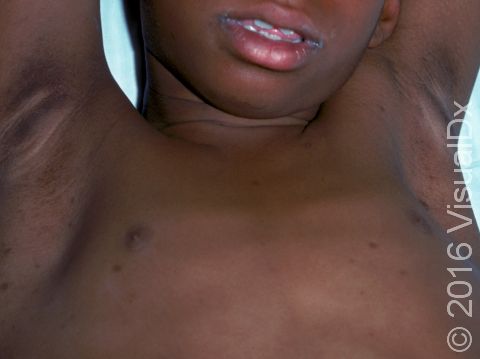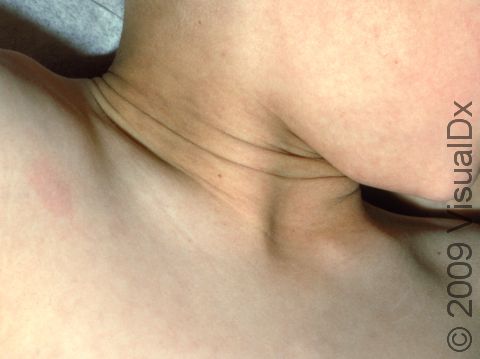Acanthosis Nigricans
Acanthosis nigricans is a condition of abnormal thickening and darkening of the skin, especially in body creases. It most commonly occurs in obese people, though it can occasionally be found in people who have more serious health problems or are taking certain medications. Treatment of the medical condition usually cures the skin lesions.
Who's At Risk?
Acanthosis nigricans can affect individuals of any age and of any ethnic background. It can develop in children and in teenagers, though it is more common in adults. Acanthosis nigricans is also more common in people with darker skin. Males and females are affected equally.
Acanthosis nigricans commonly develops in:
- Overweight or obese people
- People with diabetes or other glandular (endocrine) problems
- People taking certain medications (for example, oral contraceptives, niacinamide, or corticosteroids)
- People who have had kidney transplants
Signs & Symptoms
The most common locations for acanthosis nigricans include:
- Sides and back of the neck
- Armpits
- Groin
Less commonly, acanthosis nigricans can affect the:
- Face
- Inner thighs
- Elbows
- Knees
- Belly button (navel)
Rarely, acanthosis nigricans can occur in the:
- Nipples
- Eyelids
- Lips
- Inside of the mouth
- Anus
The lesions of acanthosis nigricans appear as “velvety” thickenings of the outer skin, and they can range in color from gray to brown to black. Darker-skinned people tend to have darker lesions.
Self-Care Guidelines
Because most people who develop acanthosis nigricans are overweight, their skin lesions can improve dramatically and even go away when they lose weight. Other medical conditions that cause these lesions should be treated as well.
Other treatments are:
- Lose weight, changing diet and exercise habits
- Apply over-the-counter preparations containing alpha-hydroxy acids such as glycolic acid or lactic acid
- Apply over-the-counter lotions containing the beta-hydroxy acid salicylic acid
- Apply over-the-counter creams containing urea
- Apply over-the-counter cortisone cream (if the areas are itchy)
Treatments
The doctor will try to establish the cause of the acanthosis nigricans. If it is due to obesity, then the doctor can help you find ways for your child to lose weight. If obesity is not a factor, the doctor may order blood tests, X-rays, or other types of tests to find the cause.
Once the medical condition has been diagnosed and treatment has been started, the doctor may recommend a topical cream or lotion containing:
- Prescription-strength alpha- or beta-hydroxy acids (glycolic acid, lactic acid, salicylic acid)
- Prescription-strength urea
- A retinoid such as tretinoin, tazarotene, or adapalene
For more severe, stubborn acanthosis nigricans, oral treatments may include:
- Fish oils taken as diet supplements
- Isotretinoin (a very strong medication with many potential side effects, often used in the treatment of severe, scarring acne)
Other procedures, not usually covered by insurance, include:
- Dermabrasion (a mechanical process of controlled, surgical scraping of the skin)
- Laser treatments (which make the skin thinner by destroying the uppermost layers)
Visit Urgency
See your child’s primary doctor if the child develops thickening and darkening of the skin folds. If the acanthosis nigricans is due to obesity, the doctor can help you find healthy ways for your child to lose weight.
See the doctor immediately if your child suddenly develops widespread acanthosis nigricans (affecting the skin folds as well as the palms of the hands, the lips, and other areas). The doctor may be able to diagnose and treat a more serious medical condition that is causing the acanthosis nigricans.
References
Bolognia, Jean L., ed. Dermatology, pp.712-115, 1717. New York: Mosby, 2003.
Freedberg, Irwin M., ed. Fitzpatrick’s Dermatology in General Medicine. 6th ed, pp. 1652, 1796. New York: McGraw-Hill, 2003.
Last modified on September 28th, 2022 at 7:35 pm

Not sure what to look for?
Try our new Rash and Skin Condition Finder
